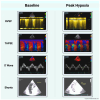Identifying the Causes of Unexplained Dyspnea at High Altitude Using Normobaric Hypoxia with Echocardiography
- PMID: 38392086
- PMCID: PMC10889907
- DOI: 10.3390/jimaging10020038
Identifying the Causes of Unexplained Dyspnea at High Altitude Using Normobaric Hypoxia with Echocardiography
Abstract
Exposure to high altitude results in hypobaric hypoxia, leading to physiological changes in the cardiovascular system that may result in limiting symptoms, including dyspnea, fatigue, and exercise intolerance. However, it is still unclear why some patients are more susceptible to high-altitude symptoms than others. Hypoxic simulation testing (HST) simulates changes in physiology that occur at a specific altitude by asking the patients to breathe a mixture of gases with decreased oxygen content. This study aimed to determine whether the use of transthoracic echocardiography (TTE) during HST can detect the rise in right-sided pressures and the impact of hypoxia on right ventricle (RV) hemodynamics and right to left shunts, thus revealing the underlying causes of high-altitude signs and symptoms. A retrospective study was performed including consecutive patients with unexplained dyspnea at high altitude. HSTs were performed by administrating reduced FiO2 to simulate altitude levels specific to patients' history. Echocardiography images were obtained at baseline and during hypoxia. The study included 27 patients, with a mean age of 65 years, 14 patients (51.9%) were female. RV systolic pressure increased at peak hypoxia, while RV systolic function declined as shown by a significant decrease in the tricuspid annular plane systolic excursion (TAPSE), the maximum velocity achieved by the lateral tricuspid annulus during systole (S' wave), and the RV free wall longitudinal strain. Additionally, right-to-left shunt was present in 19 (70.4%) patients as identified by bubble contrast injections. Among these, the severity of the shunt increased at peak hypoxia in eight cases (42.1%), and the shunt was only evident during hypoxia in seven patients (36.8%). In conclusion, the use of TTE during HST provides valuable information by revealing the presence of symptomatic, sustained shunts and confirming the decline in RV hemodynamics, thus potentially explaining dyspnea at high altitude. Further studies are needed to establish the optimal clinical role of this physiologic method.
Keywords: dyspnea; echocardiography; high altitude; hypoxic simulation testing; stress test.
Conflict of interest statement
The authors declare no conflicts of interest.
Figures


References
-
- Ulloa N.A., Cook J. StatPearls. StatPearls Publishing; Treasure Island, FL, USA: 2023. Altitude-Induced Pulmonary Hypertension. - PubMed
-
- Cornwell W.K., 3rd, Baggish A.L., Bhatta Y.K.D., Brosnan M.J., Dehnert C., Guseh J.S., Hammer D., Levine B.D., Parati G., Wolfel E.E., et al. Clinical Implications for Exercise at Altitude among Individuals with Cardiovascular Disease: A Scientific Statement from the American Heart Association. J. Am. Heart Assoc. 2021;10:e023225. doi: 10.1161/JAHA.121.023225. - DOI - PMC - PubMed
-
- Organization TICA The World of Air Transport in 2019. [(accessed on 20 June 2023)]. Available online: https://www.icao.int/annual-report-2019/Pages/the-world-of-air-transport....
LinkOut - more resources
Full Text Sources

